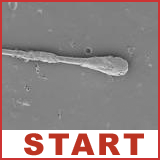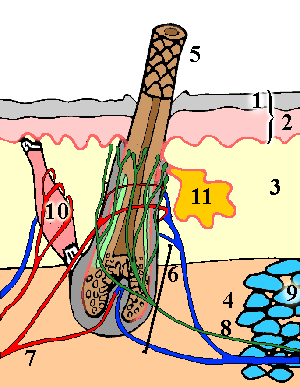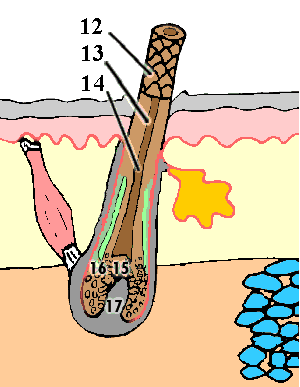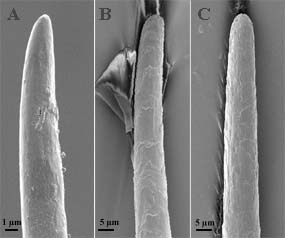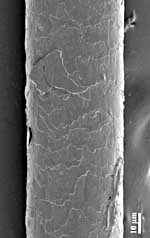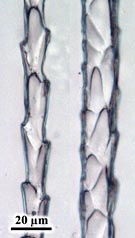Hair |
|||||||||||||||||
Hairs as strong as steel
Hairs can be considered as a differentiation product of the skin in mammals. Hairs contribute to the maintenance of a constant body temperature (homeostasis). They provide protection against excessive sun shine and dust (eyelashes and eyebrows), help to limit water loss and function as antennae corroborating with the touche sense. An interesting point for sociologists and psychologists is the question which role hair color and styling occupy as non-verbal communication attributes in our modern society. (Think for example of the "hidden messages" behind commercials on hair dyes and cosmetics as well as remedies against baldness.)
Cellular biology, chemical composition and physical strength of scalp hairsSimply speaking hairs consist of the living hair follicle in the skin and the visible hair fibre comprising scales (12; fesem detail photograph of scales 37 KB), the cortex (13) and the medulla (14), which are all made of dead cell material. The hair is lubricated at its base by the sebum produced by the sebaceous gland (11). The pilo-motor muscle (= arrector muscle; 10) is responsible for the horripilation (hair raising) phenomenon.Hairs contain lipids, water, minerals (forensic indicators for metal intoxication), melanin and keratin. Melanins granules are produced by the melanocytes (15), which are large irregularly-shaped cells in contact with the dermal papilla (17). These granules are transferred to the keratinocytes (16) in the pilar matrix at the base of the bulb, which form the medulla and cortex of the hair fibre. Keratinocytes mainly produce keratin, a protein able to build molecular chains. Single keratin molecules consist of a combination of 18 amino acids, among which cysteine that forms stable di-sulphide bridges between molecular chains. Also ionic interactions between alkalic and acid amino groups reinforce the hair cable.Four helicoidal chains of keratin molecules compose together one protofibril. Eleven twisted protofibrils combine into one microfibril and microfibrils assemble into large macrofibrils, the main structural component of -dead- fibre cells. It is this extraordinary arrangement from molecule to fibre that gives hairs their exceptional strength: a single hair (diameter 50-100 µm) can hold the tension of about a 100 g weight, so that 100000 hairs of a scalp theoretically can withstand the strain of about 10000kg! (Recommended site about "hair science") Straight or curlyThe uneven distribution of consolidating disulphide bridges in the ellipsoid hairs is responsible to for a variable degree of curling. In general people from African ethnical origin have rather flat hair viewed in cross-section compared to Caucasian people, while Asian people have the most roundish and even-sized hairs. Heat and low humidity produced by a hair dryer disrupt the structural bonds (particularly weak hydrogen bonds) enough to give hairs wounded around a roller some temporary curly aspect. However, this effect can be easily abolished by an increase in humidity or contact with water. Setting agents such as gel, hairspray and mousse provide support by coating hairs with a soluble resin. Longer lasting permanents use chemicals such as thioglycolic acid to disrupt the disulphide bonds. While the molecular structure is disrupted the hairs can be shaped to curls. Then, a counteracting product is added to restore the disulphide bridges and retain a semi-permanent wavy structure. Natural and artificial colorsAs we have seen before, melanocytes (15) give hair their color by transferring melanins, the color pigments, to the keratinocytes that form the hair fibers. The balance between the two melanins, eumelanin (strong and stable brown or black pigments) and phaeomelanin (= pheomelanins, a more yellowish-red pigment), and their total quantity determines the variety of natural hair colors: black, fair, brown, red. (see natural variations in color and size in photographs below).The synthesis of eumelanins is trigged by the enzyme tyrosinase. The appearance of white hairs seems to be caused by an interruption of the transmission of pigments from the melanocytes to the keratinocytes. Hair coloring creams are nowadays available in all colors of the rainbow. These products are generally composed of destaining substance containing hydrogen peroxide (H2O2), a cocktail of pigments and a base (high pH value), mostly ammonium and in some cases persulphate, that facilitates the penetration of the active products by opening the hair scales. Post-treatment with an mild acid product neutralizes this effect. Life cycle of hairs: initiation, growth and lost of hairsThree phases can be distinguished in the life cycle of a hair: 1. the anagen , 2. the catagen and 3. the telogen phase (diagram under construction). Hairs are formed from a primordium. During the anagen phase an intense mitotic activity takes place resulting in about 0.4 mm growth of hair per day. The anagen phase lasts in the average for 3-5 years for scalp hairs, but only 1 to 6 months for eyebrows and eyelashes (see examples hereabove). 2. The catagen phase is a short transition period (2-3 weeks for scalp hairs) characterized by growth cessation and retraction of the hair follicle. 3. The hair falls during the telogen phase. After a lapse of about 3 months for the scalp a new cycle reinitiates. Local or diffuse scalp baldness is a very common condition in nearly 50% of the world population over forty. The reasons may be diverse. Alopecia areata, which often gives rise to patches of hair loss, is believed to be an autoimmune disease. On the other hand, androgenetic alopecia develops as a response to androgens (male hormones) and results in a gradual reduction of scalp hair follicle size and shortening of the anagen period. Despite the suggestive name "androgen", both men and women may suffer from androgenic alopecia. The difference between the two genders is that women often present thinning over the whole scalp, while men additionally frequently show a receding hair line, except in the region near the neck. Hair- and scalp irritation or damage can also be caused by inappropriate washing habits or sensitivity to surfactants and other additives in shampoos (more here about) ThanksWith thanks to the persons who contributed to this project by providing hair material or images: K. Hoedemaekers, P. Timmermans, W. Overman, G. van der Zee, J. Tomlow and E. Pierson. Source of other biological material: anonymous mice and the healthiest street cat of Nijmegen. Software development: Jeroen van Beurden. Web structure: Remco Aalbers. Text and images: Elisabeth Pierson and Huub GeurtsCopyrights and disclaimer |
|||||||||||||||||
